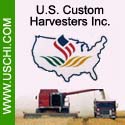 |
 |

|
|
|
North Dakota Ag News Headlines |
 |
Dakota Gardener: The Colors of Winter
By: Joe Zeleznik, NDSU Extension - 01/21/2022
It's January, and the memories of Christmas are already starting to fade. We had a houseful of people, with plenty of food and lots of fun.
Two days later, though, things got quiet pretty fast. My wife and I quickly settled into our normal winter routine, with one twist. She bought us a 3,000-piece jigsaw puzzle. Yes, 3,000 pieces! Wow. It was amazing, fun and took us 11 days to complete.
The puzzle is a colorful undersea scene with lots of tropical fish and corals. There's also a section of "sky" -- the shallow seas -- that has some pale-colored fish mixed into it.
You're probably thinking, "What does this jigsaw puzzle have to do with trees and the colors of winter?" That's a fair question and I'm getting there. Thanks for your patience.
Color variations in jigsaw puzzles are often very subtle. Over the years, I've gotten better at seeing those differences, with my wife's help. She's an artist and a quilter, and has helped me see colors, and describe them more clearly.
She's even helping me to see the colors of winter better -- specifically, the colors of trees in winter. It often seems that there's a sea of white, surrounding the upright stems of just brown and gray. And in general, that's true. But then I look more closely and the subtle differences begin to emerge.
The most common natural shade I see in winter is from redosier dogwood shrubs. Their bark is very distinct. Colors often range from fire-engine red to a deep purple-red. Other dogwoods have been selected for their pink stems, yellows or even orange. Dogwoods provide bright splashes of scattered color across the winter canvas.
For trees, at least a dozen crabapple cultivars have persistent fruit. That is, the fruit doesn't drop in the fall. Mountain-ash trees also retain their red or orange fruits into the winter. In addition to adding color to the winter palette, these trees provide food for various wildlife species.
The greens of the conifers look beautiful as well. I especially love it when they're covered in snow with their branches drooping down. Some evergreen trees are selected for their bold colors, which range from a deep dark green to silvery blue.
Look closely at the stems of large, older trees and you might be surprised at what you see. The tree trunks often provide a foundation for lichens to thrive. Lichens are complex life forms, based on a symbiotic relationship between a fungus and either an alga or a cyanobacteria.
Lichens are pretty cool. They're highly variable in shape and texture, though the colors are usually very soft. I've seen lichens that are orange, yellow-green, gray-blue and lots of gray-green ones. In the broader winter landscape, they don't show up. But if you look closely, you'll be surprised.
I also love ironwood trees in winter. They're easy to spot because of their orange-brown leaves, which they'll retain until nearly spring. The technical term for leaf retention like this is 'marcescent'. I just learned that word a few months ago, and I'll admit -- I wanted to show off.
If you want more colors, check out the fine twigs at the ends of the branches. Some of the willows are red or orange, and certain maples have bright red twigs at the ends of their large, gray branches. Though paper birch trees are mostly white, their twigs are actually a dark purple-red. It's a beautiful color, when you look closely.
It's true that most of the colors of winter are understated and not bold. But they're still attractive and fascinating. Sometimes we just need to look a little closer to find them. Kind of like those subtly-colored pieces of the jigsaw puzzle.
Other North Dakota Headlines
|
|
 |


|
 |
|
Copyright © 2024 - Farms.com. All Rights Reserved. |
 |
|